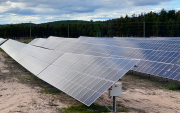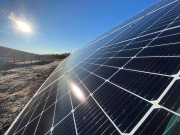This blog was written following the Pembina Institute’s attendance at the 2023 First Nations Energy Summit (FNES), hosted by Clean Energy BC. The FNES is a gathering of First Nations clean energy leaders, industry groups, B.C. policymakers, and many others who are working toward clean energy development in B.C. We are grateful to Clean Energy BC for supporting our participation at the summit.
2023 was an exciting year for clean energy policy in British Columbia. With the combined developments of a new call for power, critical funding allocations, and the ongoing implementation of the Declaration on the Rights of Indigenous Peoples Act (DRIPA), the province is taking encouraging action on the clean energy portfolio.
Looking ahead into 2024, several Indigenous and remote energy developments are worth monitoring as the B.C. energy landscape continues to evolve. This blog outlines a few policies and issues we’re keeping an eye on as the transition continues.
Opportunities from electrification
Electrification to meet the province’s legislated climate targets - including everything from electric vehicle charging and heating for homes, commercial buildings, and industrial facilities - will result in a significant increase in demand for clean power across B.C. To meet this increase in electricity demand, BC Hydro and the provincial government announced a new call for clean power (CFP) in June 2023, and recently announced $36 billion in grid infrastructure investments over the next decade. BC Hydro’s CFP creates the opportunity for independent power producers (IPPs) to compete for contracts to build clean energy generating projects and sell power to BC Hydro.
These developments are important because they create significant opportunities for First Nations’ economic participation in the clean energy transition; First Nations in B.C. have a long history of working with IPPs to produce and sell power to BC Hydro on their territories, but there has been no opportunity to do that since the end of the Standing Offer Program in 2018. This new CFP – currently being undertaken through consultation with First Nations and industry stakeholders - has First Nations participation central to the program design. While the finalized details of the call have yet to be announced, three models have been considered:
- First Nations’ endorsement on a project proposal,
- an economic benefits package to First Nations as part of a project proposal,
- or equity ownership by a First Nation.
Each of these requirements would ensure that First Nations have the opportunity to participate in and benefit from energy development on their territories.
The upcoming investments in BC Hydro’s electrical grid come with further opportunities for First Nations participation. BC Hydro has the mandate to explore shared ownership with First Nations in new transmission infrastructure. The provincial government, BC Hydro, and representatives from 11 First Nations along the North Coast of B.C. are discussing economic benefits and governance agreements for co-ownership in the planned North Coast transmission project, which will support electrifying the liquified natural gas, critical minerals, and hydrogen industries.
These opportunities are the result of strong leadership of First Nations advocating for their right to the economic benefits of energy and resource development on their territories and represent pathways for the province and BC Hydro to take initial steps towards economic reconciliation. As the province and BC Hydro continue to work with First Nations to implement DRIPA, we look forward to seeing more mechanisms and agreements that provide guaranteed economic opportunities and decision-making power to First Nations for development in their territories and continue to empower First Nations leadership in the energy sector.
Ongoing diesel reduction in remote communities
BC Hydro, the provincial government, and remote First Nations are working together to reduce diesel use and achieve the province’s goal of 80% reduction in remote community diesel consumption through the advancement of community-led clean energy projects.
The economics for clean energy generating projects in remote communities is fundamentally different from projects on the grid, as each community has their own microgrid and therefore cannot sell power back to the provincial electricity grid. Thus, the pathway to clean energy development in remote communities isn’t through a competitive process like the call for power, but through a collaborative effort between the province, BC Hydro, and remote First Nations to leverage provincial and federal grants to finance projects and remove barriers to project development.
One such barrier is the regulatory and legislative status quo, which is limited in its ability to support the rapid deployment of Nation-led diesel reducing clean energy projects. Advocates from remote First Nations are actively working with BC Hydro and the province to build collaborative platforms and advance recommendations for reform that reflect the unique nature of remote communities and recognize First Nations’ rights.
Declaration on the Rights of Indigenous Peoples Act and Collaboration
Both in the on-grid and off-grid setting, it is encouraging to see more platforms for engagement and collaboration between the province and First Nations. Engagement forums, such as the CFP engagement, the Remote Community Energy Strategy (RCES), and the Indigenous Clean Energy Opportunities (ICEO) process. These platforms create an opportunity for First Nations to shape the future of the energy industry in B.C., which is a critical aspect of B.C.’s journey of reconciliation and a good step towards DRIPA implementation. These engagement forums need to be robustly supported and expanded to facilitate the level of collaboration with First Nations necessary for DRIPA implementation.
The processes which currently shape energy and resource development in the province need to evolve to respect First Nations’ right to the productive use of the resources on their traditional territories - and their right to benefit economically from them. The B.C. provincial government, utilities, and First Nations can advance reconciliation and support climate action and economic development by working together to bring about these changes.
Conclusion
British Columbia has made strong strides in clean energy with its new call for power, a greater commitment to the inclusion of First Nations views in energy policy, and recent funding allocations. As progress continues, it will be critical for B.C. to deepen DRIPA implementation and focus on reforming energy regulation and legislation such that it creates favourable conditions for Indigenous-led clean energy development and partnerships across the province. In 2024, we are eager to follow these developments with a special focus toward clean energy advancements for remote communities in B.C.








